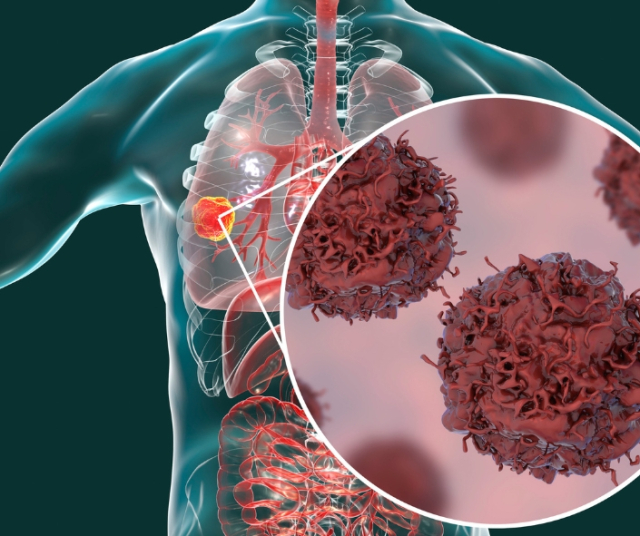Cancer is a disease that affects millions of people around the world, being one of the main causes of morbidity and mortality. It is characterized by the uncontrolled growth of abnormal cells in the body, which can form masses of tissue known as tumors. Over the years, numerous types of cancer have been identified, each with unique characteristics and varied forms of manifestation.
1. Lung Cancer
Lung cancer stands as one of the most lethal and prevalent types of cancer worldwide, with an undeniable link with tobacco consumption and other environmental factors. This type of cancer originates in the lungs and is mainly divided into two categories: small cell lung cancer and non-small cell lung cancer.
The most significant risk factor for the development of lung cancer is smoking, although exposure to secondhand smoke, air pollution, and occupational exposure to carcinogens also contribute to its incidence. Early detection is challenging, as symptoms often do not manifest until late stages. Treatment of lung cancer involves varied approaches, from surgery and radiation therapy to chemotherapy and targeted therapies. However, prevention remains the key in the fight against this devastating type of cancer.
2. Breast Cancer
Breast cancer is one of the most diagnosed types of cancer in women, although it can also affect men. It originates in breast cells and can develop in the milk ducts or lobes. Early detection through mammograms and public awareness about self-examination are critical to the successful treatment of this type of cancer.
3. Colorectal Cancer
Colorectal cancer affects the colon or rectum and is common in older people, although it can occur at any age. Most of these cancers begin as polyps in the inner lining of the colon or rectum and can become cancerous over time. Prevention and early detection are crucial, as they allow polyps to be removed before they become cancerous.
4. Leukemia
Leukemia is a cancer of the blood and bone marrow, characterized by the uncontrolled production of abnormal white blood cells. There are several types of leukemia, with acute myeloid leukemia, chronic myeloid leukemia, acute lymphocytic leukemia, and chronic lymphocytic leukemia being the most common. Treatments may include chemotherapy, radiation therapy, and bone marrow transplant.
5. Prostate Cancer
Prostate cancer is exclusive to men and originates in the prostate gland, which produces part of the seminal fluid. It is the second most common type of cancer among men. Early detection through prostate-specific antigen (PSA) testing is essential for successful treatment. Management may include surgery, radiation therapy, and hormone therapy.
6. Lymphoma
Lymphomas are cancers that affect the lymphatic system, a vital part of the immune system. There are two main types of lymphoma: Hodgkin lymphoma and non-Hodgkin lymphoma. These cancers develop in lymphocytes, a type of white blood cell. Treatment may include chemotherapy, radiation therapy, and immunotherapy, depending on the type and stage of the lymphoma.
7. Skin Cancer
Skin cancer is one of the most common types of cancer, and its incidence has been increasing in recent decades. Excessive exposure to ultraviolet (UV) radiation from the sun is a significant risk factor. The most common types are basal cell carcinoma, squamous cell carcinoma, and melanoma. Early detection is key to effective treatment.
8. Ovarian Cancer
Ovarian cancer affects the ovaries, which are part of the female reproductive system. It is known as the "silent killer" because the symptoms are usually vague and may go unnoticed in the initial stages. Surgery and chemotherapy are the main treatments, and early detection is challenging, highlighting the importance of awareness and continued research.
9. Liver Cancer
Liver cancer starts in liver cells and is more common in people with chronic liver disease. Cirrhosis, caused by excessive alcohol consumption or viral infections such as hepatitis B and C, increases the risk of developing this type of cancer. Treatments may include surgery, liver transplant, chemotherapy, and radiation therapy.
10. Cervical Cancer
Cervical cancer, one of the most prevalent forms of cancer in women, originates in the cells of the cervix, the lower part of the uterus that connects to the vagina. Its close connection to human papillomavirus (HPV) infection makes it distinctive, as certain types of HPV, especially high-risk HPV, are associated with an increased risk of developing this type of cancer.
This largely preventable cancer is notable for its relationship with HPV, a common sexually transmitted infection. Early detection is crucial, and Papanicolaou (Pap) tests have been shown to be effective tools for identifying abnormal cellular changes in the cervix before they turn into cancer. Additionally, HPV vaccination has been shown to be an effective strategy to prevent infection and therefore reduce the risk of cervical cancer.
Cervical cancer presents a global challenge, affecting women worldwide, especially in regions with limited access to health services and screening programs. Public awareness of the importance of screening and vaccination is essential to comprehensively address this issue.
Treatments for cervical cancer can vary depending on the stage of the disease and include options such as surgery, radiation therapy, and chemotherapy. However, the key remains prevention, highlighting the need for broader and more accessible vaccination programs, as well as the promotion of regular screening for early detection.
